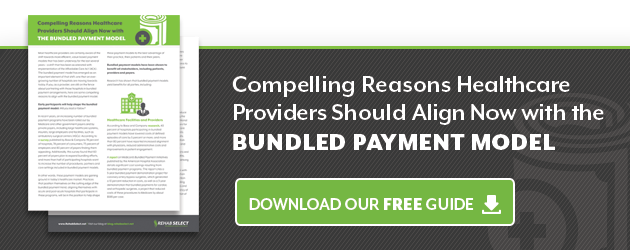 The bundled payment model is on the rise in today's healthcare marketplace, with a growing number of government and corporate payers testing new bundling plans as an alternative to the traditional fee-for-service payment model. The goal of these initiatives is to reduce the costs of healthcare while maintaining or improving the quality of care patients receive. While many healthcare providers have already had experience with this value-based payment model, many others have not. If you are one of them, chances are you have questions about bundled payments.
The bundled payment model is on the rise in today's healthcare marketplace, with a growing number of government and corporate payers testing new bundling plans as an alternative to the traditional fee-for-service payment model. The goal of these initiatives is to reduce the costs of healthcare while maintaining or improving the quality of care patients receive. While many healthcare providers have already had experience with this value-based payment model, many others have not. If you are one of them, chances are you have questions about bundled payments.
Here, we'll go over 4 FAQs about the bundled payment model.
What, exactly, is a bundled payment?
Bundled payments link payment for services, rendered by various healthcare providers, throughout a defined episode of care. Rather than paying for each service separately, a single, preset price is paid for the entire episode, which is divided among participating providers. For instance, bundled payment for joint replacement surgery generally pays one set price for care that includes initial surgical consults, the surgery, and acute care hospitalization, as well as post-acute care, including rehabilitation services, follow-up care, and any home health or skilled nursing center services needed during a defined post-operative period—typically 90 days.
How does the bundled payment model work to lower costs and improve care?
Under the bundled payment model, provider groups who keep costs for an episode of care at or below the agreed-upon target price while meeting clearly defined quality-of-care standards are eligible for financial rewards under gain sharing and performance award provisions. Conversely, providers that go over budget may be financially liable, typically by having to absorb at least a portion of the excess costs, and failure to meet quality benchmarks means the loss of quality-based performance awards.
This system of shared risk, shared gain, and quality-of-care benchmarks provides incentives to streamline the care process by eliminating inefficiencies that can inflate costs, such as unnecessary or redundant tests and/or treatments. The effort to eliminate inefficiencies requires that all healthcare providers involved in each episode work together in close collaboration, leading to more efficient coordination of care. Better coordination of care promotes improved quality-of-care and better patient outcomes.
What is a convener?
Conveners are entities that take the lead on bundled payments. Most often these are hospitals, physician groups, or integrated healthcare systems—although some post-acute care entities, such as skilled nursing facilities, rehabilitation hospitals, or home health agencies are also conveners, most commonly in bundles that include only post-acute care.
Conveners assume the responsibility of achieving the cost and quality benchmarks built into the bundled payment plan, overseeing the care process from start to finish. Any savings generated on an episode of care is shared with the convener, and they are responsible for a portion of any losses. The convener may choose to share savings and/or losses with other providers involved in the episode of care.
What basic infrastructure will your practice need to succeed under the bundled payment model?
Among the essential elements needed to make the most of the bundled care model are data sharing capability across providers, including clinical, quality, and cost data; and good data analytics for use in identifying high-risk patients and monitoring real-time performance. An efficient care management system and standardized care protocols are also essential to minimize variations in costs and quality among episodes of care.





